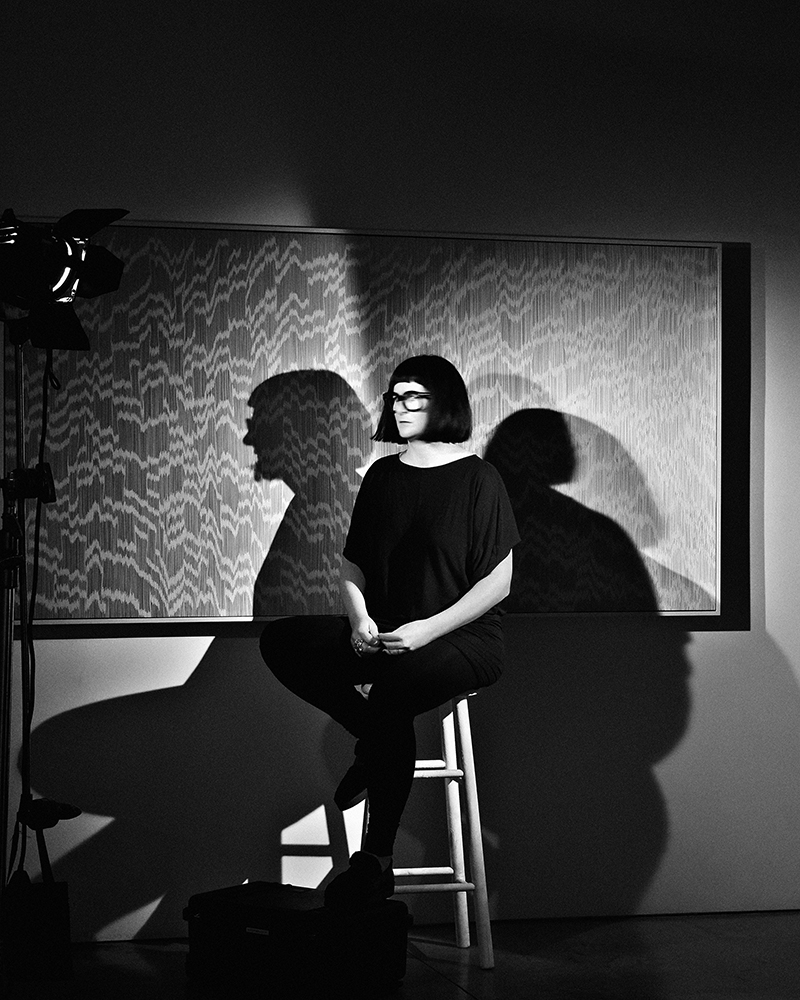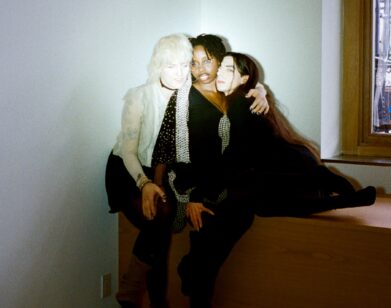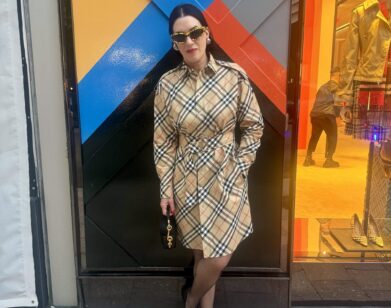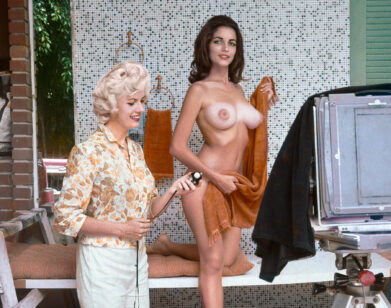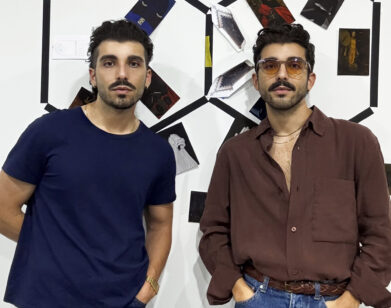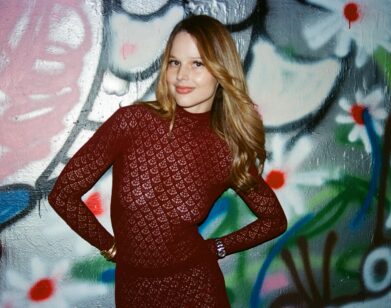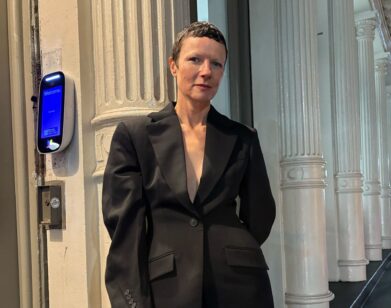Tara Donovan’s Decks
TARA DONOVAN IN NEW YORK, FEBRUARY 2017. PORTRAITS: DEAN PODMORE.
Buttons, toothpicks, No. 2 pencils, Styrofoam cups—these are all objects that have metamorphosed into sculptures in the hands of Tara Donovan. The New York-based artist, who was awarded the first-ever Calder Prize in 2005 and the MacArthur “Genius Grant” in 2008, is known for transforming mundane, mass-produced commodities into large-scale, surreal structures.
Most of Donovan’s inventions resemble nature: precariously stacked shirt buttons appear like stalagmites in Bluffs; scotch tape gathers like mist hovering above the floor in Nebulous; and plastic drinking straws layered against a wall give the impression of a fleeting sheet of fog in Haze. In Styrofoam Cup Sculpture, cups are suspended from the ceiling in a configuration that not only mimics the shape of looming clouds, but also their movement.
Although her works often evoke a sense of the sublime prevalent in natural phenomena, there is nothing accidental nor incidental about Donovan’s creations. She researches light and patterns, and her arrangements are strategic. In 2014, as part of the group exhibition “Wonder” at the Smithsonian Art Museum’s Renwick Gallery, Donovan constructed ten massive towers (the tallest at 13 feet) by meticulously stacking hundreds of thousands of index cards; the result was a room-sized mountain range of rock formations not unlike Cappadocia, Turkey’s geological site of “fairy chimneys.”
“Tara Donovan,” the artist’s current exhibition at Pace Gallery’s 24th Street location in New York, however, is more contained. The series on display, Compositions (Cards), consists of wall-mounted square frames in which styrene cards are stacked and adhered vertically in various formations. All of the works share the series title, and while some resemble landscapes or textiles and others have more geometric patterns, they all possess an illusory quality. By manipulating the spaces between each individual card, Donovan adds almost a third dimension to her pieces, and the works subtly shift with what she calls a “filmic quality” upon the movement (and perception) of viewers.
Interview caught up with Donovan prior to her show opening last week to talk about Compositions (Cards) and the significance of the image.
PIMPLOY PHONGSIRIVECH: I’m curious about the series title, Compositions (Cards), and whether it has anything to do with music.
TARA DONOVAN: I chose the term because it spoke to the hybrid nature of the works. They have the linearity of drawing, the materiality of painting, and the volumetric depth of sculpture. I had leftover material from the sculpture at Pace in 2014 [which was later shown in the “Wonder” exhibition at the Renwick Gallery].
PHONGSIRIVECH: Index cards, right?
DONOVAN: The material is based off of index cards, yes, but these are actually styrene so that they don’t yellow and disintegrate.
PHONGSIRIVECH: These are incredibly elaborate. How long does one take to make?
DONOVAN: Not long at all. Anywhere between three days and three weeks, which is actually very quick in relation to my overall practice, which can sometimes be extremely labor-intensive. Depending on the pattern—some of them start very mathematically, some are very organic and intuitive.
PHONGSIRIVECH: So I recently watched this video of you—
DONOVAN: Uh-oh…
PHONGISIRVECH: [laughs] And you said, “Inspiration is a joke. Real artists sit down and work.”
DONOVAN: [laughs] Yes, well, I don’t think inspiration just comes from the sky. I think you have to sit down and you have to work. Sometimes it’s really hard, and sometimes things come easier, but really you have to show up, you have to get to work, and you have to have determination. Especially for myself, I don’t work with the same material over and over so I have to start from scratch every time. There’s a learning curve and by the time I’ve finished with something I feel like I have “figured it out.”
PHONGSIRIVECH: What are some things that have been “figured out”?
DONOVAN: In some of these, there are three hues—black, white, and gray—and that was a discovery that came from learning different ways of stacking the cards. I’ve always been interested in the idea of grayscale and how it affects perceptual shifts. The pin drawings I did [Drawings (Pins)] were based on investigating grayscale with a physical material.
PHONGSIRIVECH: These almost look blue.
DONOVAN: Yes. I like to refer to color as a fugitive quality. Individually, the cards appear as just white, but when white materials or translucent materials are amassed in large accumulations, fugitive colors begin to announce themselves, like how the edge of a piece of glass is almost a greenish color.
PHONGSIRIVECH: And so you’ve stacked them differently how?
DONOVAN: The third color basically comes in by double-spacing the cards. So you can see how much it shifts by expanding the spacing of the cards. At first sight, it has the implied order of a grid, but when you really look at it closely, it’s not very orderly at all. It winds up taking on this kind of iridescent quality.
PHONGSIRIVECH: That sounds quite mathematical.
DONOVAN: Some patterns emerge organically, and some are more researched and calculated. [One] has an art deco quality. There are some funny references.
PHONGSIRIVECH: One of them reminds me of mountains, like peaks.
DONOVAN: [gestures to works on the wall] This one reminds me of camouflage. It feels camo-y. This one feels very textile to me, and this one like sand. Like the water coming up, you know? [mimics tides] And this one feels very geological. Or sperm-y. [laughs]
PHONGSIRIVECH: Yes—how do you refer to these?
DONOVAN: Well, I don’t. In public, I don’t usually. In the studio we have nicknames for all of them, but I do that with all of my works. They’re usually really goofy monikers to help us all understand which ones we are referring to.
PHONGSIRIVECH: So with all of these, someone else could look at them and see something completely different. You don’t have certain images you want to evoke?
DONOVAN: No, the images for these are somewhat insignificant to me. It became an exercise of variation. I only see the surface images as doodles in a sketchbook, but it’s hard to not see an image and bring some kind of personal association, though there’s not a prescribed idea of what you’re supposed to see.
The image itself is kind of the least important factor to me, though I’m still interested in putting forth an interesting image. I see the image as the screen laid over top of what really interests me, which is that depth of surface and that filmic quality that it has when you pass the piece. The idea that these look like paintings, but are most definitely not, is really interesting to me. [runs finger through cards]
PHONGSIRIVECH: It almost looks like you’re flipping through a book.
DONOVAN: Nobody ever believes it, but the series came about when I was shuffling a deck of cards—a deck of Uno cards to be exact. I’m excited to see what I can do next with these. I’ve discovered some things. I can’t wait to get back to the studio.
“TARA DONOVAN” IS ON VIEW AT PACE GALLERY‘S 24TH STREET LOCATION IN NEW YORK THROUGH MARCH 18, 2017.

